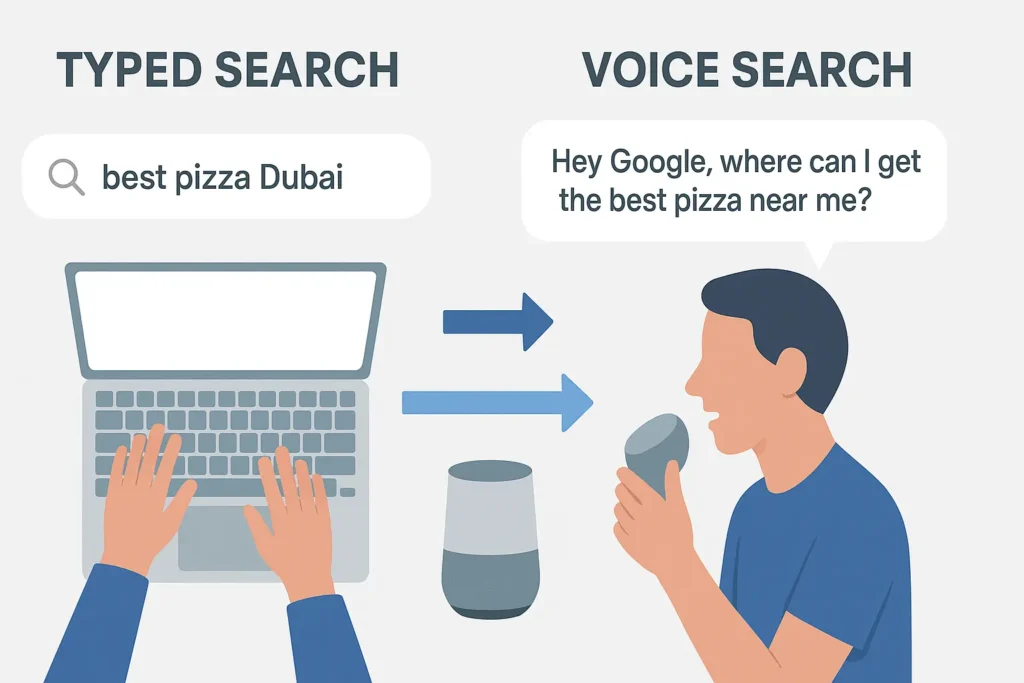The digital landscape is changing rapidly and the way users interact with content is evolving just as fast. With the proliferation of Amazon Alexa, Google Home and a whole range of voice assistants in smartphones and smart speakers more people than ever are searching with their voices rather than their keyboards. This shift is more than a trend it’s a fundamental change in search behavior. For businesses and marketers voice search optimization is now essential for maintaining and growing your organic presence in SEO in 2025 and beyond.
The Fundamentals of Voice Search Optimization
Voice search optimization involves adjusting your websites content and technical foundation so that it appears as the answer to spoken questions rather than just typed queries. The old approach of stuffing short keywords onto a page is obsolete. Today voice search SEO requires you to understand natural language queries create content in a conversational tone and focus on the actual intent behind every users question. This means writing in a way that feels human addressing the kinds of questions someone might say out loud to a smart speaker or phone and providing clear accurate and quick answers.
Searches made by voice are generally longer and more detailed as users are not limited by typing speed or convenience. They might ask “How can I improve my websites loading speed for mobile users?” or “What are the best practices for voice search SEO in 2025?” rather than just typing “voice search optimization.” When you optimize for these full conversational questions you set your website up to meet real user needs and capture more relevant high-converting traffic.
Why Voice Search SEO is a 2025 Priority
The numbers are staggering. More than 8 billion devices globally now feature some form of voice assistant and the share of searches made by voice increases every year. Smart speakers are not only in homes they’re in offices, hotels and even cars. The convenience of hands-free search and the rise of on the go information needs means businesses that adapt to voice search optimization are setting themselves up for massive success.
In 2025 voice search SEO is no longer optional. Businesses that ignore this shift risk missing out on a large fast-growing segment of search driven users. Not only do voice queries tend to be more local and more transactional but they also show stronger purchase intent. People use voice assistants to find businesses nearby compare services get quick facts and even place orders. Capturing this voice search traffic often means winning the zero-click battle as most voice devices only deliver a single answer making first place in the rankings more important than ever.
Adapting Your Content for Voice Search Optimization
evolution to a voice search SEO strategy starts with re thinking your content. The first step is writing in a natural conversational style that mirrors how people speak. Instead of focusing on keywords like “SEO 2025” or “content refresh” aim to weave long-tail keywords and conversational queries into your text. Use complete questions and answers and frame your content around solving user problems as efficiently as possible.
A great starting point is to update your most important pages and blog posts with Q&A sections. For each topic imagine what a real person might ask a smart speaker about your business or service. For instance if you run a digital marketing agency people might ask, “What is the difference between local SEO and traditional SEO?” or “How do I make my website mobile-friendly for voice search?” Create brief clear answers to these questions and embed them within your content ideally at the top of the relevant page so search engines and voice assistants can quickly find and use them.
Here’s how to structure your content for voice search optimization:
- Write answers that are clear, concise, and conversational.
- Place important questions in headings and immediately answer them.
- Use follow-up paragraphs to provide in-depth information for users who want more detail.
- Regularly review your content and add new Q&As as search trends evolve.
Beyond the FAQ sections every part of your website can benefit from voice search optimization. Product descriptions, landing pages and even your homepage should use language that is easy to read aloud. Try reading your text out loud to see if it sounds natural if it feels awkward or too technical revise for clarity and conversational tone.

Understanding the Role of Schema Markup and Structured Data
A huge factor in voice search optimization is helping search engines identify the exact answers within your content. This is where structured data and schema markup come in. By tagging your Q&A sections, FAQ pages and other informational content with the appropriate schema you make it much easier for Google and Alexa to pick out the precise information to use as a spoken answer. Schema markup can turn your page into a potential source for featured snippets the short summaries that appear at the top of Google results and are often chosen for voice responses.
For business owners implementing FAQ schema is an easy win. When you add FAQ Page schema to a section of your site you are signaling to Google that this content is designed for quick direct answers. This increases the chances that your answers will be used by Google Assistant or Google Home. If your business is in a highly competitive niche leveraging schema for How To content, product info and reviews can help set you apart and build your authority. Remember structured data is not a ranking factor by itself but it helps search engines understand your contents relevance and context which in turn can impact your organic rankings and improve your chances in voice search SEO.
The main benefits of adding schema markup for voice search optimization are:
- Improved chances of appearing in featured snippets and voice answers.
- Clearer communication with search engines about your contents purpose.
- Enhanced visibility in both text and voice search results.
- Better support for local, how-to, and FAQ queries.
Local SEO The Backbone of Voice Search
A significant portion of voice search activity is local. People are using their smart speakers and digital assistants to find solutions nearby restaurants, services, events and more. That means your voice search optimization efforts need to be closely tied to local SEO best practices. Keep your Google Business Profile and Bing Places listings fully up to date. Make sure your business name, address and phone number are consistent everywhere online. Respond to reviews and answer common questions in your business profile.
Inside your site, mention your location naturally within content. Rather than simply stating your city or region use phrases such as “We serve clients throughout Dubai, the Marina, and the JLT area.” This type of conversational location information aligns with the way users phrase voice queries and increases your likelihood of being chosen by a voice assistant for local questions.
To go deeper, study your web analytics and see what “near me” or regional searches are already bringing people to your website. Then, update your existing content to reflect those needs and expand with new articles targeting trending local topics. For more targeted strategies on regional queries refer to our comprehensive guide Local SEO Dubai UAE Strategies & Tips.
Speed, Mobile and the Technical Edge
A top factor in voice search SEO success is your websites technical performance. Google’s research shows that voice search results pages load significantly faster than the average site, and this is no accident. When users interact with voice assistants they expect immediate answers. If your website is slow you’re not only losing voice traffic you’re probably losing out on traditional search rankings as well.
To optimize conduct a website audit focused on mobile speed and usability. Compress your images, streamline your code and ensure every page displays flawlessly on smartphones and tablets. Googles mobile-first indexing means that your sites mobile version is the primary version used for rankings. This is even more crucial for voice search optimization as most voice queries are done on mobile or smart speaker platforms. HTTPS security is also essential Google and Alexa both prefer secure trustworthy sites when selecting answers for users. The latest Web Design Trends 2025 UX, Mobile First, AI Innovations report offers actionable insights for making your site both attractive and effective in the age of mobile and voice-driven search.
Content Refresh and Historical Optimization for Voice Search SEO
Many businesses already have a rich archive of articles and landing pages. Instead of creating new content for every possible voice query you can achieve excellent results by updating and optimizing what you already have a strategy known as content refresh or historical optimization. Regularly audit your website looking for high-traffic or high-potential pages that haven’t been updated recently. Revise these with voice search optimization in mind add new questions and answers update statistics and rewrite sections to use more conversational language and focus on user intent.
This process helps you maintain evergreen content that continues to perform year after year. A well optimized frequently refreshed site signals to Google that you are an authority in your field which improves both your organic rankings and your odds of being selected as a voice search answer. If you want to go even further, review our step-by-step guide to content refresh in Rank Without Backlinks SEO. Even without a huge link profile well-optimized up-to-date content can dominate voice search and traditional queries alike.
Answering Featured Snippets and Quick Answers
A major goal in voice search optimization is to be selected for Googles featured snippets. These are the concise answer boxes shown at the top of search results and are the primary sources for spoken answers given by Google Home and Assistant. To maximize your chances answer each user question directly and succinctly preferably within the first paragraph after a question is asked. Avoid long-winded overly complex explanations at the start get to the point then expand further below for users who want more details.
Keep your responses in the 30 to 40 word range for top visibility. This approach not only helps with voice search SEO but also improves the overall user experience since your visitors will quickly find the answers they need. Over time these optimizations can lead to more zero-click results where users get what they need without leaving the results page establishing your site as a trusted authoritative resource.
Monitoring Results and Evolving Your Voice Search SEO Strategy
Optimization doesn’t stop once changes are made. Keep an eye on your site’s analytics especially for long-form and question-based queries. These are strong indicators that your voice search optimization efforts are working. Use Google Search Console and Bing Webmaster Tools to identify which pages are picking up new voice traffic then iterate on what’s working adding more questions updating answers and refining your schema markup as new best practices emerge.

Mistakes to Avoid in Voice Search Optimization
The transition to voice search SEO brings new challenges. Businesses often make the mistake of relying on old habits overusing keywords, neglecting mobile experience or skipping schema markup. Avoid writing generic keyword-stuffed articles. Instead craft content that is direct, conversational and helpful this is what voice assistants select and users trust.
Some of the most common mistakes include:
- Relying on outdated keyword strategies instead of conversational queries.
- Overlooking mobile site performance and slow page load times.
- Not keeping business listings on Google or Bing up to date.
- Skipping FAQ schema or failing to provide direct answers to user questions.
- Writing content that is too generic or lacks clear value for the user.
Another common error is to ignore your Google or Bing business listings. Since so many voice searches are local and rely on these platforms for information out-of-date or incomplete listings mean missed opportunities. Update them regularly respond to reviews and ensure every detail is accurate. Finally remember that voice search optimization is not just about the homepage or blog every part of your website should be ready for voice from service descriptions to support content and beyond.
The Power of Internal Linking in Voice Search SEO
Strategic internal linking is vital for both traditional and voice SEO. By connecting related articles and resources you help both users and search engines understand the full depth of your expertise. When updating older content always look for opportunities to add new internal links to recently published voice-optimized pages and vice versa. This improves time on site user engagement and the overall effectiveness of your voice search optimization strategy.
Final Thoughts Voice Search Optimization for the Future
Voice search is not a passing trend it is rapidly becoming the default way many people discover information, products, and services. Businesses that adapt quickly to voice search optimization will position themselves as industry leaders, trusted sources and customer favorites. The combination of technical improvements, conversational content, local focus, and continuous content refresh ensures your website remains visible relevant and ready for whatever the next wave of SEO innovation brings.
Start today by reviewing your most visited pages. Update your Q&A sections, refine your answers and monitor your results. Every step you take towards voice readiness is a step towards a more resilient and successful business in the digital age.


2 Responses